Electrochemically-Obtained Polysulfonic-Acids Doped Polyaniline Films—A Comparative Study by Electrochemical, Microgravimetric and XPS Methods
Abstract
:1. Introduction
2. Materials and Methods
3. Results and Discussion
3.1. Coupled Electrochemical and Microgravimetric Measurements in the Course of Polymerization
3.2. Electrochemical Redox Behavior and Stability
3.3. XPS Studies
4. Conclusions
Author Contributions
Funding
Conflicts of Interest
References
- Geniès, E.M.; Boyle, A.; Lapkowski, M.; Tsintavis, C. Polyaniline: A historical survey. Synth. Met. 1990, 36, 139–182. [Google Scholar] [CrossRef]
- Ciric-Marjanovic, G. Recent advances in polyaniline research: Polymerization mechanisms, structural aspects, properties and applications. Synth. Met. 2013, 177, 1–47. [Google Scholar] [CrossRef]
- Mozafari, M.; Singh, N.P. (Eds.) Fundamentals and Emerging Applications of Polyaniline; Elsevier: Amsterdam, The Netherlands, 2019. [Google Scholar]
- Cao, Y.; Smith, P.; Heeger, A.J. Counter-ion induced processibility of conducting polyaniline and of conducting polyblends of polyaniline in bulk polymers. Synth. Met. 1992, 48, 91–97. [Google Scholar] [CrossRef]
- Trivedi, D.C. Influence of the anion on polyaniline. J. Solid State Electrochem. 1998, 2, 85–87. [Google Scholar] [CrossRef]
- Motheo, A.J.; Santos, J.R., Jr.; Venancio, E.C.; Mattoso, L.H.C. Influence of different types of acidic dopant on the electrodeposition and properties of polyaniline films. Polymer 1998, 39, 6977–6982. [Google Scholar] [CrossRef]
- Barra, G.M.O.; Leyva, M.E.; Gorelova, M.M.; Soares, B.G.; Sens, M. X-Ray Photoelectron Spectroscopy and Electrical Conductivity of Polyaniline Doped with Dodecylbenzenesulfonic Acid as a Function of the Synthetic Method. J. Appl. Polym. Sci. 2001, 80, 556–565. [Google Scholar] [CrossRef]
- Lyutov, V.; Georgiev, G.; Tsakova, V. Comparative study on the electrochemical synthesis of polyaniline in the presence of mono-and poly (2-acrylamido-2-methyl-1-propanesulfonic) acid. Thin Solid Film. 2009, 517, 6681–6688. [Google Scholar] [CrossRef]
- Mahat, M.M.; Mawad, D.; Nelson, G.W.; Fearn, S.; Palgrave, R.G.; Payne, D.J.; Stevens, M.M. Elucidating the deprotonation of polyaniline films by X-ray photoelectron spectroscopy. J. Mater. Chem. C 2015, 3, 7180–7186. [Google Scholar] [CrossRef]
- Hyodo, K.; Nozaki, M. High ion selective electrochemical synthesis of polyaniline. Electrochim. Acta 1988, 33, 165–166. [Google Scholar] [CrossRef]
- Kang, Y.; Lee, M.H.; Rhee, S.B. Electrochemical properties of polyaniline doped with poly (styrenesulfonic acid). Synth. Met. 1992, 52, 319–328. [Google Scholar] [CrossRef]
- Liu, F.-J.; Huang, L.-M.; Wen, T.-C.; Li, C.-F.; Huang, S.-L.; Gopalan, A. Platinum particles dispersed polyaniline-modified electrodes containing sulfonated polyelectrolyte for methanol oxidation. Synth. Met. 2008, 158, 767–774. [Google Scholar] [CrossRef]
- Kuo, C.-W.; Wen, T.-C. Dispersible polyaniline nanoparticles in aqueous poly (styrenesulfonic acid)via the interfacial polymerization route. Europ. Polym. J. 2008, 44, 3393–3401. [Google Scholar] [CrossRef]
- Kuo, C.-W.; Kuo, P.-L.; Ho, K.-S.; Hsieh, T.-H.; Chen, S.-J.; Wu, T.-Y.; Huang, Y.-C. Polyaniline Doped with Various Inorganic Acids and Polymeric Acids as Platinum Catalyst Support for Methanol Electro-oxidation. J. Chin. Chem. Soc. 2012, 59, 1294–1302. [Google Scholar] [CrossRef]
- Kuo, C.-W.; Chen, S.-J.; Chen, P.-R.; Wu, T.-Y.; Tsai, W.-T.; Tsen, C.-G. Doping process effect of polyaniline doped with poly(styrenesulfonic acid) supported platinum for methanol oxidation. J. Taiwan Inst. Chem. Eng. 2013, 44, 497–504. [Google Scholar] [CrossRef]
- Shen, J.; Shahid, S.; Sarihan, A.; Patterson, D.A.; Emanuelsson, E.A.C. Effect of polyacid dopants on the performance of polyaniline membranes in organic solvent nanofiltration. Sep. Purif. Technol. 2018, 204, 336–344. [Google Scholar] [CrossRef]
- Lyutov, V.; Tsakova, V.; Bund, A. Microgravimetric study on the formation and redox behavior of poly (2-acrylamido-2-methyl-1-propanesulfonate)-doped thin polyaniline layers. Electrochim. Acta 2011, 56, 4803–4811. [Google Scholar] [CrossRef]
- Lyutov, V.; Ivanov, S.; Mirsky, V.; Tsakova, V. Polyaniline doped with poly (acrylamidomethylpropanesulphonic acid): Electrochemical behaviour and conductive properties in neutral solutions. Chem. Pap. 2013, 67, 1002–1011. [Google Scholar] [CrossRef]
- Nekrasov, A.A.; Gribkova, O.L.; Eremina, T.V.; Isakova, A.A.; Ivanov, V.F.; Tverskoj, V.A.; Vannikov, A.V. Electrochemical synthesis of polyaniline in the presence of poly(amidosulfonic acid)s with different rigidity of polymer backbone and characterization of the films obtained. Electrochim. Acta 2008, 53, 3789–3797. [Google Scholar] [CrossRef]
- Nekrasov, A.A.; Gribkova, O.L.; Ivanov, V.F.; Vannikov, A.V. Electroactive films of interpolymer complexes of polyaniline with polyamidosulfonic acids: Advantageous features in some possible applications. J. Solid State Electrochem. 2010, 14, 1975–1984. [Google Scholar] [CrossRef]
- Gribkova, O.L.; Nekrasov, A.A.; Trchova, M.; Ivanov, V.F.; Sazikov, V.I.; Razova, A.B.; Tverskoy, V.A.; Vannikov, A.V. Chemical synthesis of polyaniline in the presence of poly (amidosulfonic acids) with different rigidity of the polymer chain. Polymer 2011, 52, 2474–2484. [Google Scholar] [CrossRef]
- Gribkova, O.L.; Ivanov, V.F.; Nekrasov, A.A.; Vorobev, S.A.; Omelchenko, O.D.; Vannikov, A.V. Dominating influence of rigid-backbone polyacid matrix during electropolymerization of aniline in the presence of mixtures of poly (sulfonic acids). Electrochim. Acta 2011, 56, 3460–3467. [Google Scholar] [CrossRef]
- Gribkova, O.L.; Nekrasov, A.A.; Ivanov, V.F.; Zolotorevsky, V.I.; Vannikov, A.V. Templating effect of polymeric sulfonic acids on electropolymerization of aniline. Electrochim. Acta 2014, 122, 150–158. [Google Scholar] [CrossRef]
- Gribkova, O.L.; Omelchenko, O.D.; Nekrasov, A.A.; Ivanov, V.F.; Vannikov, A.V. On the nature of influence of polyelectrolyte molecular weight on aniline electropolymerization. J. Solid State Electrochem. 2015, 19, 2643–2652. [Google Scholar] [CrossRef]
- Nekrasov, A.A.; Gribkova, O.L.; Ivanov, V.F.; Vannikov, A.V. The Spectroelectrochemical Behavior of Films of Polyaniline Interpolymer Complexes in the Near Infrared Spectral Region. Russ. J. Electrochem. 2012, 48, 197–204. [Google Scholar] [CrossRef]
- Guseva, M.A.; Isakova, A.A.; Gribkova, O.L.; Tverskoi, V.A.; Ivanov, V.F.; Vannikov, A.V.; Fedotov, Y.A. Matrix polymerization of aniline in the presence of polyamides containing sulfo acid groups. Polym. Sci. Ser. A 2007, 49, 4–11. [Google Scholar] [CrossRef]
- Wu, Z.L.; Arifuzzaman, M.; Kurokawa, T.; Le, K.; Hu, J.; Sun, T.L.; Furukawa, H.; Masunaga, H.; Gong, J.P. Supramolecular assemblies of a semirigid polyanion in aqueous solutions. Macromolecules 2013, 46, 3581–3586. [Google Scholar] [CrossRef]
- Kang, E.T.; Neoh, K.G.; Khor, S.H.; Tan, K.L.; Tan, B.T.G. Xps studies of charge transfer interactions in some polyaniline complexes. Polymer 1990, 31, 202–207. [Google Scholar] [CrossRef]
- Kumar, S.N.; Gaillard, F.; Bouyssoux, G. High-resolution XPS studies of electrochemically synthesized conducting polyaniline films. Synth. Met. 1990, 36, 111–127. [Google Scholar] [CrossRef]
- Kang, E.T.; Neoh, K.G.; Tan, K.L. Protonation and deprotonation of polyaniline films and powders revisited. Synth. Met. 1995, 68, 141–144. [Google Scholar] [CrossRef]
- Chen, Y.; Kang, E.T.; Neoh, K.G.; Lim, S.L.; Ma, Z.H.; Tan, K.L. Intrinsic redox states of polyaniline studied by high-resolution X-ray photoelectron spectroscopy. Colloid Polym. Sci. 2001, 279, 73–76. [Google Scholar] [CrossRef]
- Dauginet-De Pra, L.; Demoustier-Champagne, S. A comparative study of the electronic structure and spectroelectrochemical, properties of electrosynthesized polyaniline films and nanotubes. Thin Solid Films 2005, 479, 321–328. [Google Scholar] [CrossRef]
- Golczak, S.; Kanciurzewska, A.; Fahlman, M.; Langer, K.; Langer, J.J. Comparative XPS surface study of polyaniline thin films. Solid State Ion. 2008, 179, 2234–2239. [Google Scholar] [CrossRef]
- Lin, Y.-C.; Hsu, F.-H.; Wu, T.-M. Enhanced conductivity and thermal stability of conductive polyaniline/graphene composite synthesized by in situ chemical oxidation polymerization with sodium dodecyl sulfate. Synth. Met. 2013, 184, 29–34. [Google Scholar] [CrossRef]
- Tan, J.S.; Marcus, P.R. Ion Binding in Sulfonate-Containing Polyelectrolytes. J. Polymer Sci. Polym. Phys. Ed. 1976, 14, 239–250. [Google Scholar] [CrossRef]

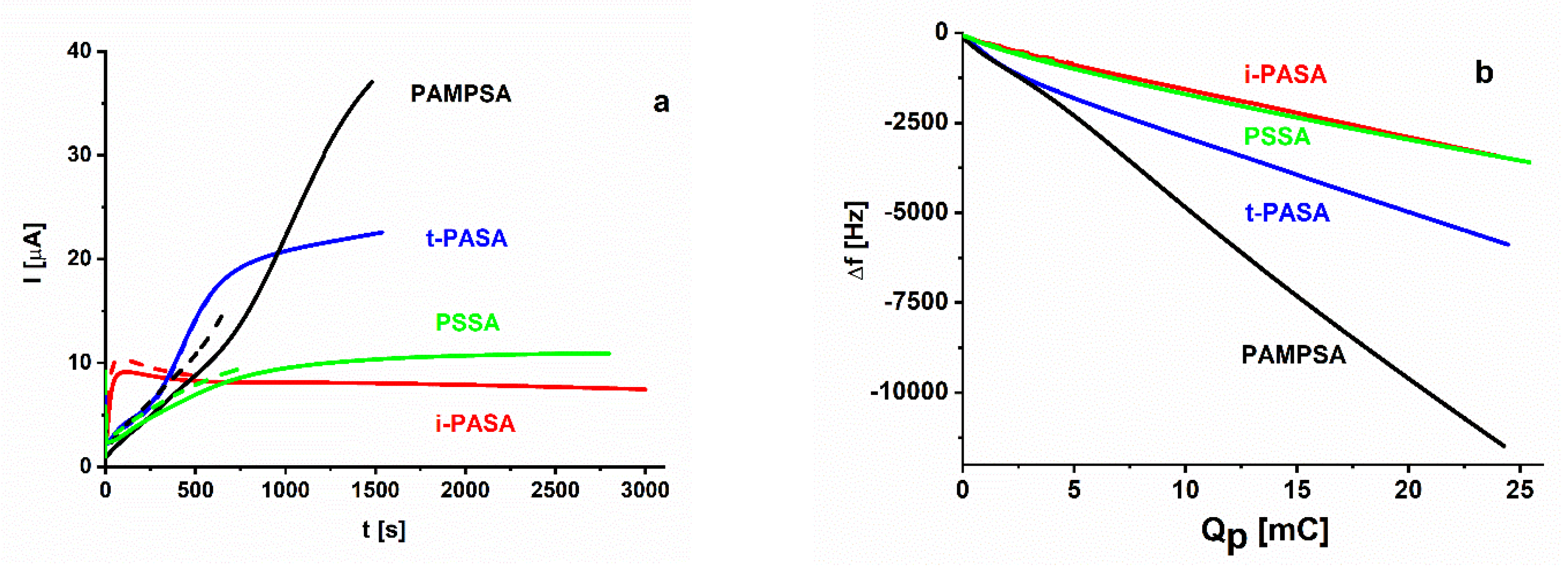
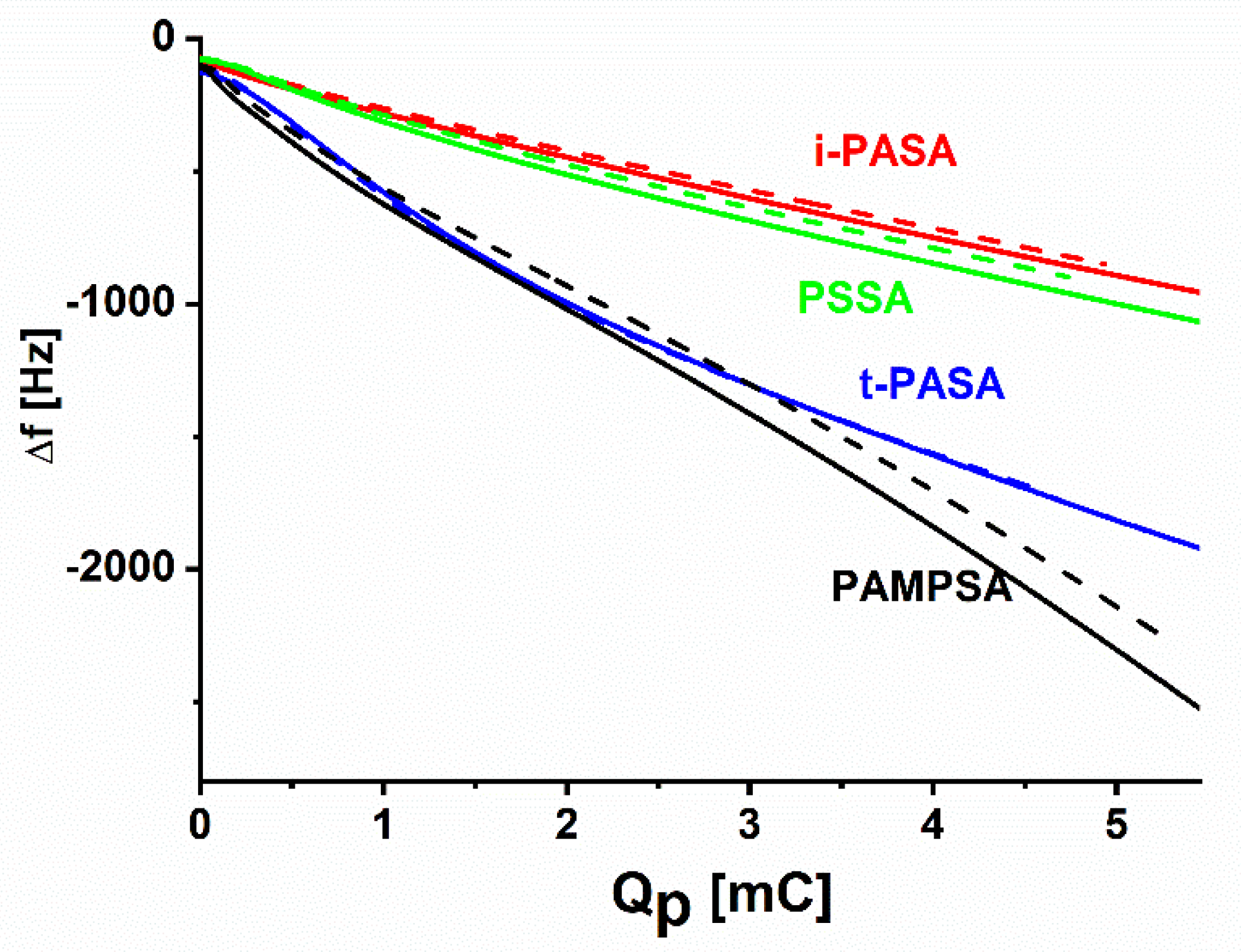
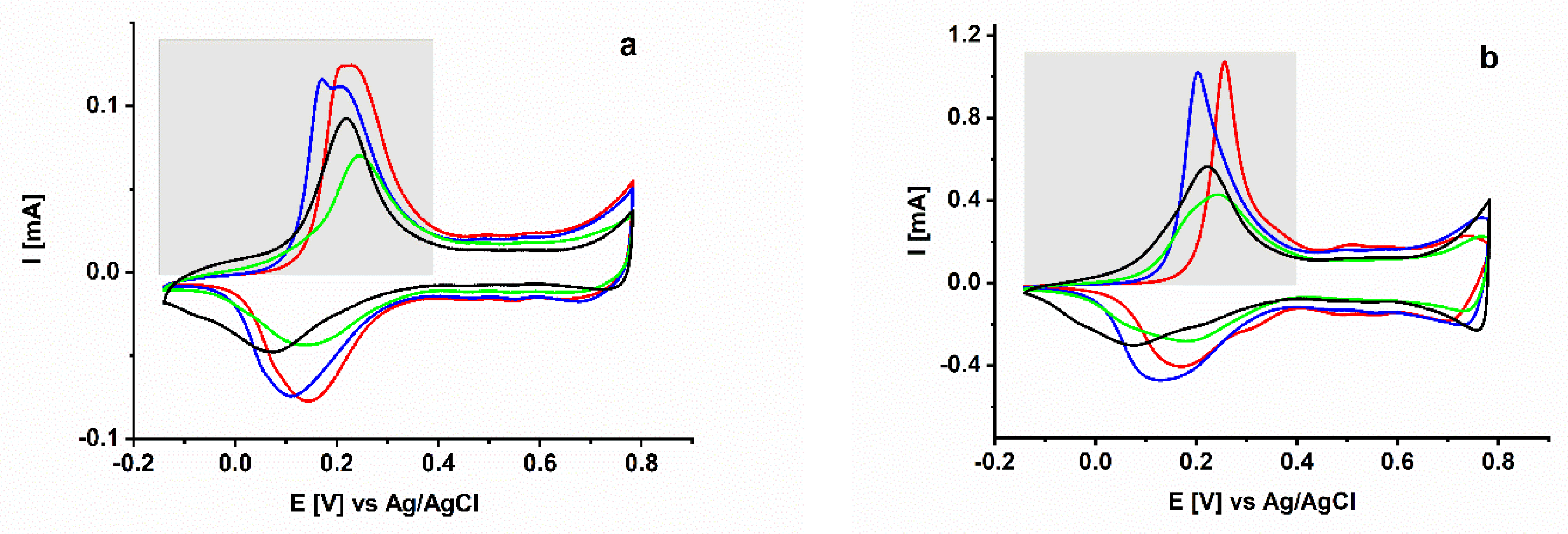
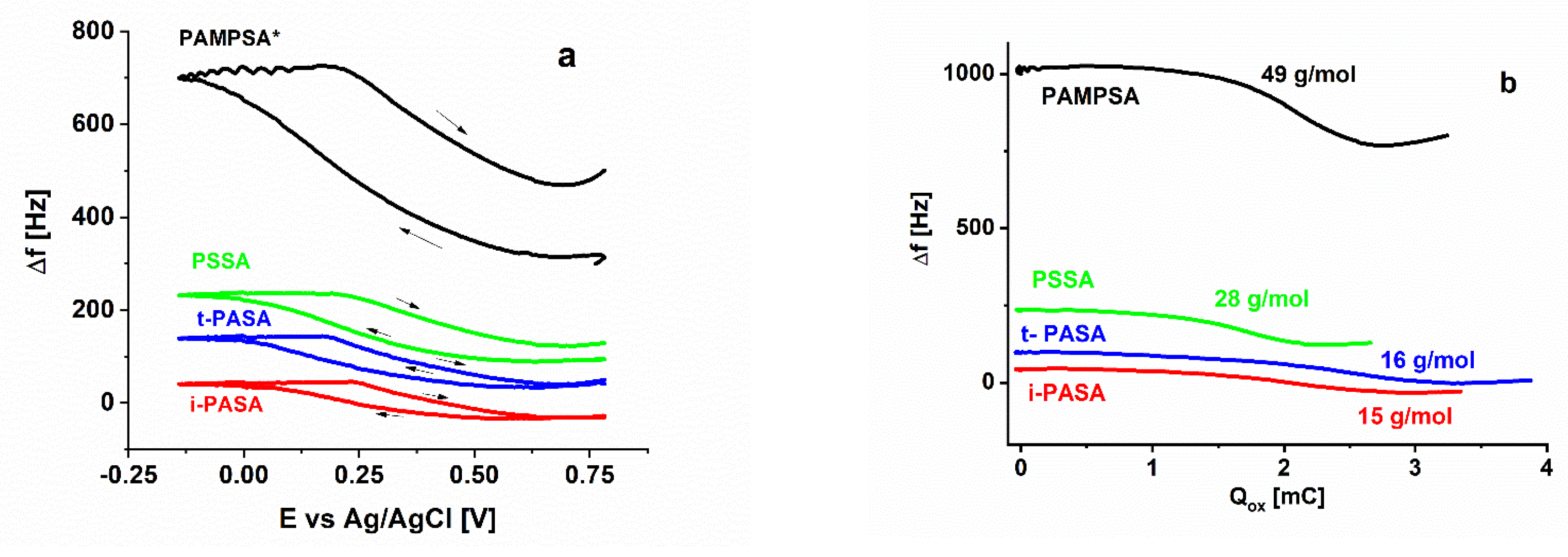
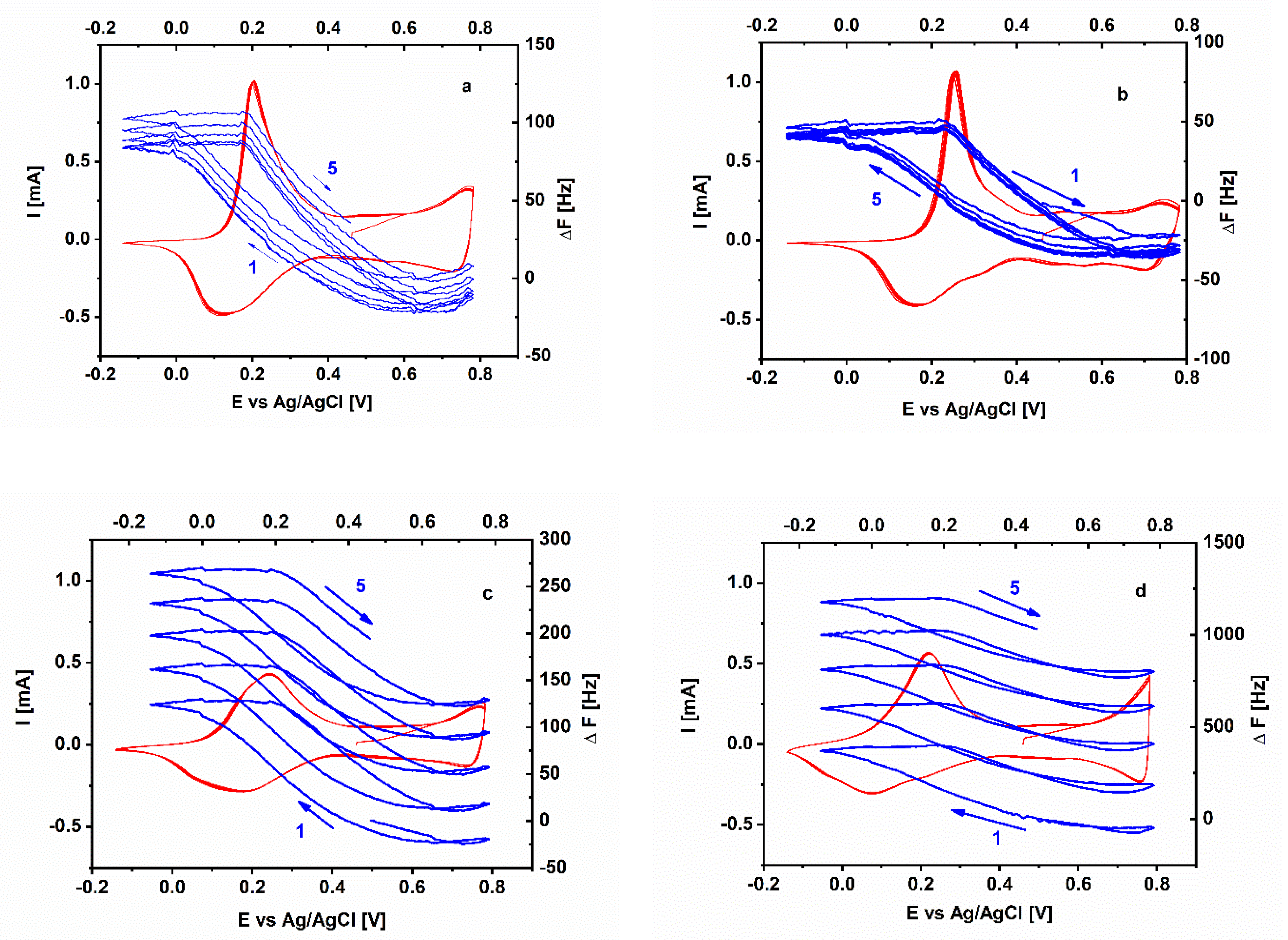
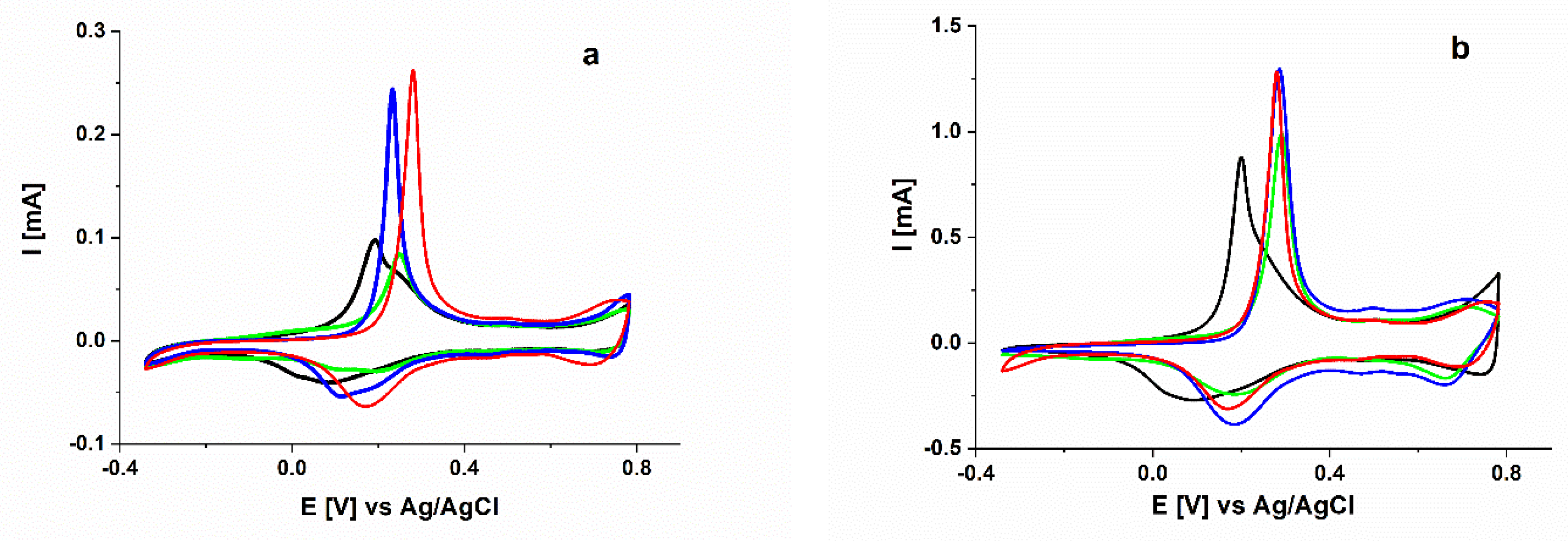

| Dopant | Molar Mass of Dopant i g/mol | Δf at Qpoly = 1 mC/ kHz | Mass Change/ µg | Mapp Experiment/ g/mol | MStoichiomet. Doping/ g/mol |
|---|---|---|---|---|---|
| (1) | (2) | (3) | (4) | (5) | (6) |
| t-PASA | 474 | 0.48 | 2.129 | 514 | 209.5 |
| 0.26 ii | 1.152 ii | 278 ii | 209.5 | ||
| i-PASA | 474 | 0.19 | 0.849 | 205 | 209.5 |
| PSSA | 184 | 0.21 | 0.948 | 229 | 183.0 |
| PAMPSA | 207 | 0.46 | 2.053 | 495 | 194.5 |
| Dopant | t-PASA | i-PASA | PSSA | PAMPSA | ||||
|---|---|---|---|---|---|---|---|---|
| Type of Film | Thin | Thick | Thin | Thick | Thin | Thick | Thin | Thick |
| After synthesis | 0.20 | 0.24 | 0.18 | 0.20 | 0.12 | 0.15 | 0.13 | 0.20 |
| After storage | 0.17 | 0.20 | 0.17 | n. a. | 0.12 | 0.15 | 0.14 | 0.20 |
| N | Dopant | Ntot at % | Stot at % | N(a) 398.5 eV % | N(b) 399.7 i eV % | N(c) 401.1 eV % | N(d) 402.2 eV % | N(c+d)/ (Ntot-Stot) | Nc/ (Ntot-Stot) | Stot/ (Ntot-Stot) |
|---|---|---|---|---|---|---|---|---|---|---|
| (2) | (3) | (4) | (5) | (6) | (7) | (8) | (9) | (10) | (11) | |
| 1 | t-PASA | 8.90 | 2.85 | 4.5 | 60.7 | 18.2 | 16.6 | 0.51 | 0.27 | 0.47 |
| 2 | i-PASA | 8.98 | 2.85 | 4.37 | 64.79 | 15.93 | 14.90 | 0.45 | 0.23 | 0.46 |
| 3 | PSSA | 7.24 | 2.80 | 6.26 | 52.26 | 27.40 | 14.08 | 0.32 ii | 0. 27 ii | 0.39 ii |
| 4 | PAMPSA-thick | 10.61 | 3.59 | 4.8 | 60.7 | 22.1 | 12.4 | 0.52 | 0.33 | 0.51 |
| 5 | PAMPSA-thin | 10.17 | 3.45 | 7.07 | 59.8 | 21.85 | 11.28 | 0.50 | 0.33 | 0.51 |
| % from Ntotal | ||||||||||
| Dopant, Synthetic Method | Deconvoluted N 1 s Peak Peak Positions (eV) | XPS Ref. Line | Doping % | Ref. | |||
|---|---|---|---|---|---|---|---|
| –N = (a) | –NH– (b) | –NH+ (c) | = NH+ (d) | ||||
| PSSA, chemical synthesis | 398.1 | 399.3 | 400.1 | 401.3 | n.a. | 30–38 | [13] |
| PSSA, elchem. synthesis in H2SO4 chemical reduction to EB; redoped | 398.8 | 399.6 | 400.7 | 401.8 | n.a. | 32 | [12] |
| PSSA or PAA, elchem. synthesis in H2SO4, chemical reduction to EB, redoped | 398.8 | 399.6 | 400.7 | 401.8 | n.a. | 47 | [14] |
| PSSA - elchem. synthesis in H2SO4 chemical reduction to EB, redoped | 398.7 | 399.6 | 400.5 | 401.4 | n.a | 35–40 | [15] |
| PSSA, PAMPSA chemical synthesis of ES, deprotonation to EB | 398.5 | 399.5 | 401.1 | 402.2 | 284.6 C 1s | 43 | [16] |
| dodecylbenzene sulfonic acid, chemical synthesis | 398.2 | 399.6 | 400.8 | 402.0 | 284.6 C 1s | 46 | [7] |
| p-toluenesulfonate, camphorsulfonate, chemical synthesis, doped EB | 398.5 | 399.5 | 401.1 | 402.2 | 284.6 C1s | 22.5 29.2 | [9] |
| Cl−, electrochem. synthesis | No peak | 399.2 | 401.1 | 403.1 | 284.8 C 1s | 25.4 | [32] |
| Cl−, electrochem. synthesis | 398.5 | 399.6 | 401.1 | 402.6 | 284.5 C 1s | 20–25 thin 12–13 thick | [33] |
| dodecylsulfate, chem. synthesis | 398.6 | 399.2 | above 400 | 51.2 | [34] | ||
© 2020 by the authors. Licensee MDPI, Basel, Switzerland. This article is an open access article distributed under the terms and conditions of the Creative Commons Attribution (CC BY) license (http://creativecommons.org/licenses/by/4.0/).
Share and Cite
Lyutov, V.; Kabanova, V.; Gribkova, O.; Nekrasov, A.; Tsakova, V. Electrochemically-Obtained Polysulfonic-Acids Doped Polyaniline Films—A Comparative Study by Electrochemical, Microgravimetric and XPS Methods. Polymers 2020, 12, 1050. https://doi.org/10.3390/polym12051050
Lyutov V, Kabanova V, Gribkova O, Nekrasov A, Tsakova V. Electrochemically-Obtained Polysulfonic-Acids Doped Polyaniline Films—A Comparative Study by Electrochemical, Microgravimetric and XPS Methods. Polymers. 2020; 12(5):1050. https://doi.org/10.3390/polym12051050
Chicago/Turabian StyleLyutov, Vladimir, Varvara Kabanova, Oxana Gribkova, Alexander Nekrasov, and Vessela Tsakova. 2020. "Electrochemically-Obtained Polysulfonic-Acids Doped Polyaniline Films—A Comparative Study by Electrochemical, Microgravimetric and XPS Methods" Polymers 12, no. 5: 1050. https://doi.org/10.3390/polym12051050
APA StyleLyutov, V., Kabanova, V., Gribkova, O., Nekrasov, A., & Tsakova, V. (2020). Electrochemically-Obtained Polysulfonic-Acids Doped Polyaniline Films—A Comparative Study by Electrochemical, Microgravimetric and XPS Methods. Polymers, 12(5), 1050. https://doi.org/10.3390/polym12051050







